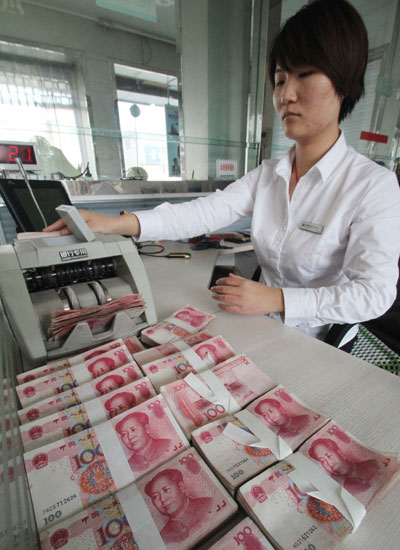Yuan set to be more flexible
Updated: 2012-10-30 09:43
By Wang Xiaotian (China Daily)
|
||||||||
Renminbi trading band may be broadened this year, say analysts
China might, in the last two months of the year, further broaden the permitted fluctuation limits of the yuan to the daily mid-point set by the central bank, analysts forecast.
|
 |
|
A worker counts renminbi banknotes at a rural credit cooperative in Linyi, Shandong province. The yuan has appreciated by more than 2.4 percent since late July, when it touched 6.3967, its weakest point for the year. [Photo/China Daily] |
"We expect such fluctuation limits to be extended from the current 1 percent to 2.5 percent after the United States presidential election, and the 18th National Congress of the Communist Party of China (due to start on Nov 8)," said Lu Zhengwei, chief economist at the Industrial Bank.
He said interest rates and banks' reserve requirement ratio are unlikely to be adjusted in November given the current economic situation.
Related reading: HK will still be offshore yuan center: US offcial
Li Wei, an economist at Standard Chartered Bank, said: "No one can rule out the possibility that the trading band is further widened. Such a move would send a strong signal to the market that the yuan is further liberalized and more market-driven.
"This would also be in line with China's long-term economic reform in a bid to improve market efficiency."
He declined to comment on the possible timing for such a move, but said a more flexible yuan will eventually come about and Chinese businesses will have to adapt to this change and come up with better business practices.
Chen Daofu, policy research chief of the Financial Research Institute at the State Council's Development Research Center, said: "The current fluctuation limits already seem sufficient for the market."
He said broadening the yuan's range depends on the demand of market players, and if market forces demonstrate greater appetite for trading in the currency, such a decision might follow.
The People's Bank of China, the central bank, announced in April that the yuan would be allowed to fluctuate by 1 percent from a daily mid-point - double the previous 0.5 percent.
Since then, the currency has depreciated against the dollar while the world's second-largest economy slowed for seven consecutive quarters, before starting to pick up in recent months as it stabilizes and major economies such the US, the European Union, the United Kingdom and Japan announced new easing policies.
The yuan has strengthened more than 2.4 percent since touching its weakest point of the year at 6.3967 in late July. Compared with the start of the year, it has appreciated by 0.8 percent.
"What the central bank needs to fix now is not to broaden the floating band of the yuan, but to solve the deviation in the daily reference rate it set from the real market situation," said Ding Zhijie, dean of the School of Banking and Finance at the University of International Business and Economics in Beijing.
"If we look at the past few months since the band was broadened to 1 percent, 99 percent of the daily yuan fluctuations did not touch the upper and lower limits at all."
He said the problem is that the official daily pricing cannot sufficiently reflect market demand. "For instance, today (Monday), the central bank set the mid-point at 6.299 against the dollar. In just 15 minutes the trading price went to 6.245."

 Relief reaches isolated village
Relief reaches isolated village
 Rainfall poses new threats to quake-hit region
Rainfall poses new threats to quake-hit region
 Funerals begin for Boston bombing victims
Funerals begin for Boston bombing victims
 Quake takeaway from China's Air Force
Quake takeaway from China's Air Force
 Obama celebrates young inventors at science fair
Obama celebrates young inventors at science fair
 Earth Day marked around the world
Earth Day marked around the world
 Volunteer team helping students find sense of normalcy
Volunteer team helping students find sense of normalcy
 Ethnic groups quick to join rescue efforts
Ethnic groups quick to join rescue efforts
Most Viewed
Editor's Picks

|

|

|

|

|

|
Today's Top News
Health new priority for quake zone
Xi meets US top military officer
Japan's boats driven out of Diaoyu
China mulls online shopping legislation
Bird flu death toll rises to 22
Putin appoints new ambassador to China
Japanese ships blocked from Diaoyu Islands
Inspired by Guan, more Chinese pick up golf
US Weekly

|

|






